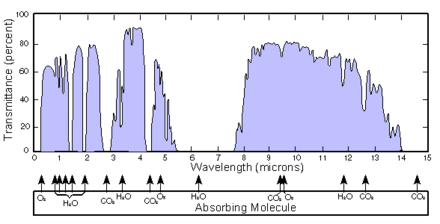J band (infrared)

Atmospheric windows in the infrared. The J band is the transmission window (1.1 to 1.4 um) centred on 1.25 micrometres
In infrared astronomy, the J band refers to an atmospheric transmission window (1.1 to 1.4 um) centred on 1.25 micrometres (in the near-infrared).
Betelgeuse is the brightest near-IR source in the sky with a J band magnitude of −2.99.[1] The next brightest stars in the J band are Antares (−2.7), R Doradus (−2.6), Arcturus (−2.2), and Aldebaran (−2.1).[2] In the J band Sirius is the 9th brightest star.
References[]
- ^ R. Cutri and M. Skrutskie (2009-09-07). "Very Bright Stars in the 2MASS Point Source Catalog (PSC)". The Two Micron All Sky Survey at IPAC. Retrieved 2011-12-28.
- ^ "Simbad object query:Jmag<-2 & Vmag>-9". SIMBAD Astronomical Database. Retrieved 2012-08-22.
Categories:
- Electromagnetic spectrum
- Infrared imaging
- Astronomy stubs
